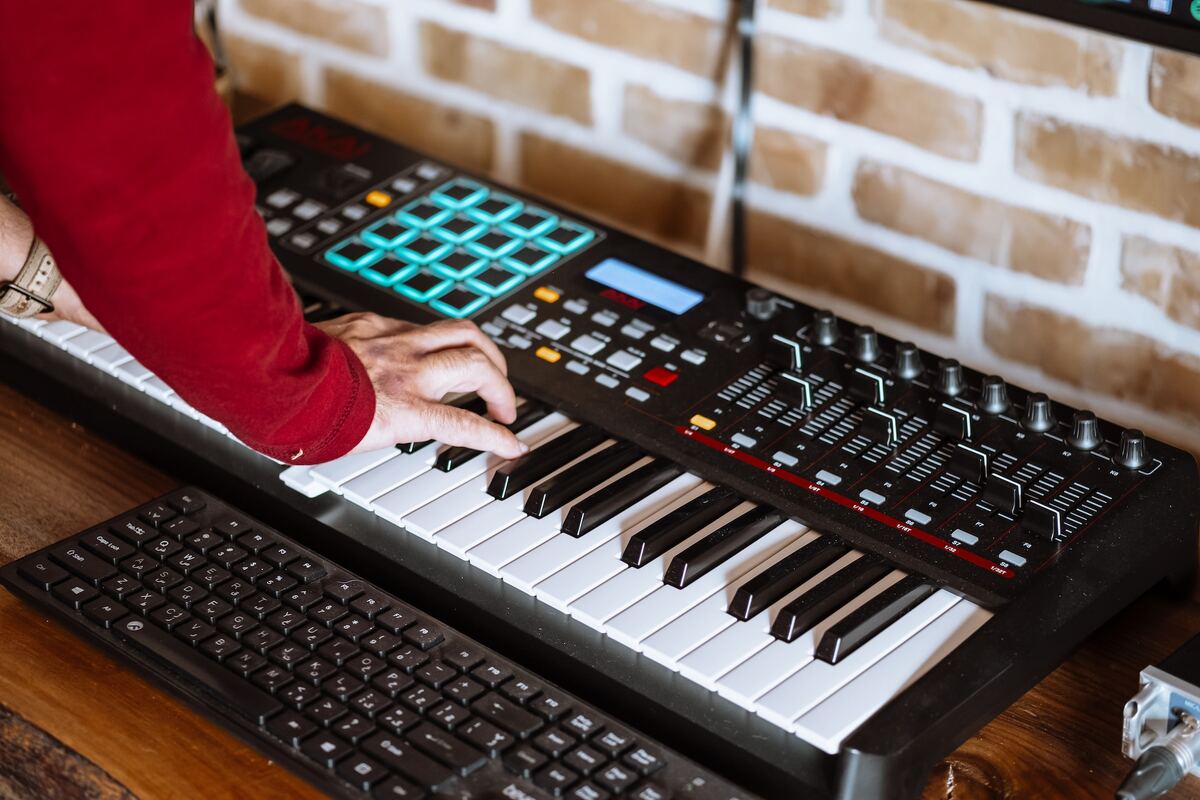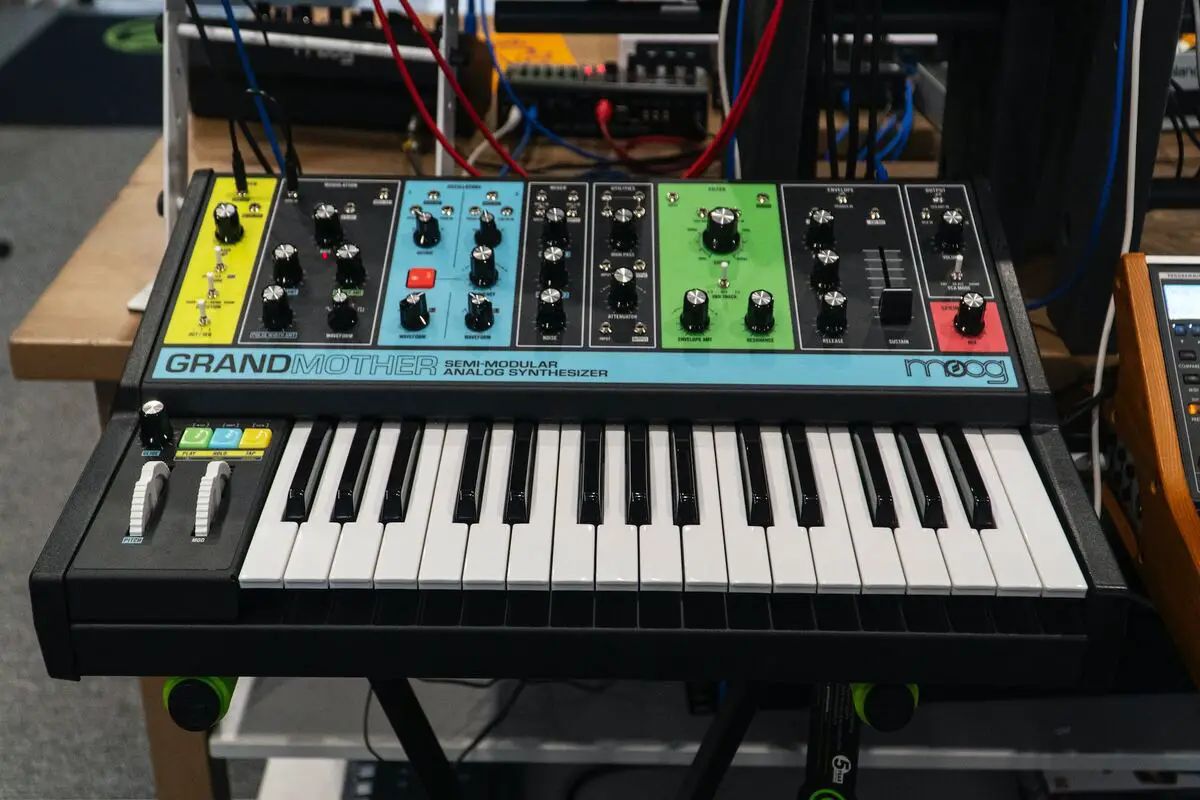Far more than a mere instrument, a synthesizer allows musicians to craft an unparalleled range of sounds, from replicating traditional instruments to creating brand-new, otherworldly tones. Whether you’re listening to the pulsating beats of electronic dance music, the lush textures in a film score, or the iconic riffs of classic rock songs, the synthesizer’s versatility and impact are undeniable.
What is a synthesizer? A synthesizer, commonly referred to as a synth, is an electronic musical instrument that produces sound by generating signals. It’s currently a dominant instrument in the production of popular music genres such as pop, hip-hop, and EDM.
What is a synthesizer, and how does it work?
A synthesizer, commonly known as a synth, is an electronic musical instrument that generates sound by generating signals. It’s the powerhouse behind popular music genres like pop, hip-hop, and EDM that dominate the airwaves today. But what sets a synthesizer apart from traditional instruments is its ability to manipulate and sculpt soundwaves, giving musicians unprecedented creative control.

At its core, a synthesizer consists of several key components that work together harmoniously to produce unique sounds. Oscillators, such as sine, sawtooth, and square waves, create the basic building blocks of sound. Filters then shape these waveforms to emphasize or attenuate specific frequencies, resulting in varied and rich tones.
Additionally, LFOs (Low-Frequency Oscillators) generate rhythmic modulation effects, and the ADSR envelope controls the evolution of sound over time, determining how quickly a sound starts, fades away, sustains, and releases.
AKAI Professional MPK Mini MK3

AKAI Professional MPK Mini MK3
How did the synthesizer evolve?
The history of the synthesizer is rich with innovation and creativity. It has reshaped the sonic landscape of modern music and traces its origins to early electronic innovations. Here is a brief look at its evolution:
- Early 20th Century: Pioneering electronic instruments like the Telharmonium and Theremin introduced the concept of generating sound without traditional means, laying the groundwork for future developments.
- 1960s: The modern synthesizer era began with Robert Moog’s Moog Modular and Donald Buchla’s Buchla Box, which introduced voltage-controlled oscillators and filters.
- 1970s: The decade saw a surge in popularity with iconic instruments like the Minimoog and Yamaha’s CS-80. Synthesizers became staples in various music genres.
- 1980s: Digital synthesis arrived with the Yamaha DX7, utilizing FM synthesis. The introduction of MIDI revolutionized electronic music production by allowing devices to communicate seamlessly.
- 1990s – Early 2000s: The digital age brought software synthesizers and virtual analog models, enabling musicians to emulate classic analog sounds using computers.
- 2010s: A revival in analog and modular synthesizers occurred, with a surge in interest in the Eurorack modular format and reissues of classic designs.
What are the different types of synthesizers available?
Synthesizers come in various types, each offering unique features, interfaces, and sound generation methods. Here are some of the primary types of synthesizers:
- Analog synthesizers: These synths harness the power of analog circuits to create sound, offering a warm and organic tone reminiscent of the vintage classics. Think of legendary instruments like the Moog Model D or the Sequential Circuits Prophet-5, which shaped the sound of the ’60s and ’70s.
- Digital synthesizers: With the advancement of technology, digital synthesizers emerged in the ’80s, leveraging digital signal processing to generate sounds. These synths excel in versatility and precision, offering a vast range of customizable options.
- Software synthesizers: Software synths, or plugins, have revolutionized music production by running directly within a Digital Audio Workstation (DAW). From virtual analog synths to realistic emulations of acoustic instruments, software synths provide musicians with endless sonic possibilities right at their fingertips.
- Modular synthesizers: Modular synths take synthesis to a whole new level, offering complete customization and a sense of “building” your own instrument. Comprised of individual modules like oscillators, filters, and LFOs, they allow for experimental sound design and endless exploration.
What are the different styles of synthesis?
Synthesizers utilize various synthesis methods to generate sounds. Each style offers unique timbral possibilities, and many modern synthesizers may employ multiple methods. Here are some of the primary styles of synthesis:
- Additive Synthesis: This technique involves layering multiple sine waves to build complex tones. By controlling the amplitude and frequency of each wave, you can create rich and textured sounds, resembling real-world instruments or entirely unique sonic landscapes.
- Subtractive Synthesis: As one of the most popular synthesis techniques, subtractive synthesis starts with complex waveforms and uses filters to remove or attenuate certain frequencies, sculpting the sound and achieving the desired timbre. It’s a versatile approach that allows for creating everything from fat basslines to funky leads.
- FM (Frequency Modulation) Synthesis: FM synthesis takes a different route, using a modulator signal to change the pitch of another signal. By manipulating the modulation depth and frequency, you can achieve distinctive and complex timbres, often characterized by metallic and bell-like tones.
- Wavetable Synthesis: Wavetable synthesis involves sampling individual notes from real instruments and parsing them into a sequence of small audio snippets called wavetables. These wavetables can be combined, looped, and manipulated to create evolving and expressive sounds.
- Modular Synthesis: This style of synthesis allows for complete customization by combining individual modules according to personal preference. It’s a playground for experimentation, enabling musicians to create entirely unique sounds that push the boundaries of traditional music norms.
Can I create realistic instrument sounds with a synthesizer?
While synthesizers are often associated with creating futuristic and electronic sounds, they are also capable of producing incredibly realistic instrument sounds. Digital synthesizers, in particular, excel in emulating real-world instruments. For example, software synths can accurately replicate the timbre of a grand piano, the warmth of a vintage analog synth, or the twang of an electric guitar.
From orchestral instruments to exotic world instruments, synthesizers provide musicians with a cost-effective way to access an expansive library of sounds.
With advancements in technology, multisampled instruments and sophisticated sample-based synthesis techniques have made it possible to recreate a wide variety of instruments with astonishing realism. From orchestral instruments to exotic world instruments, synthesizers provide musicians with a cost-effective way to access an expansive library of sounds.
Moreover, even with subtractive synthesis, you can use filters and modulation techniques to sculpt synthesized sounds to closely resemble acoustic instruments. By utilizing techniques like velocity-sensitive dynamics and expressive modulation assignments, you can breathe life into your synthesizer performances.
Why is a synthesizer important for music production?
By now, you may be wondering why you should dive into the world of synthesizers and explore their sonic capabilities. Well, the answer is simple: synthesizers empower you to unleash your musical creativity like never before. Whether you’re a seasoned musician or just starting your musical journey, synthesizers offer an unparalleled range of sounds and effects. They allow you to craft unique, attention-grabbing music that stands out in a sea of generic tunes.

Creating a home recording studio or delving into music production often involves the integration of synthesizers. These versatile instruments can take your recordings to the next level, whether you’re adding lush pads, funky basslines, or soaring leads to your tracks. With the rise of affordable and compact synthesizers, it has become easier than ever to incorporate them into your own creative space. So, if you’re looking to add depth and complexity to your music, consider using the power of synthesis within your own studio setup.
Here’s a table outlining key points to consider of synthesizers:
| Dos | Don’ts |
|---|---|
| Experiment and explore different sounds | Neglect the basics of sound synthesis |
| Learn the fundamentals and technical aspects | Rely solely on presets |
| Customize presets to fit your own style | Overdo the effects and lose clarity |
| Utilize modulation to add depth and movement | Limit yourself to one synthesis technique |
| Keep learning and stay curious | Ignore the power of manual control |
How do you choose the right synthesizer for your needs?
Choosing the right synthesizer can feel like a daunting task given the vast array of options available. However, with some consideration, you can find the perfect match for your musical aspirations. Here are a few key factors to keep in mind:
- Budget: Determine how much you’re willing to invest in a synthesizer. Analog synths tend to be more expensive, while digital and software synths offer more affordable options.
- Sound Preference: Consider the type of sound you want to achieve. If you’re after warm, vintage tones, analog synthesizers may be your best bet. For versatility and a wide range of sound possibilities, digital and software synths excel.
- Features and Functionality: Think about the features and functionality you need. Do you require an extensive range of built-in effects and modulation options? Are you looking for hands-on control with knobs and sliders? Each synthesizer offers a unique set of features, so prioritize what matters most to you.
- Integration with your Setup: If you’re already using a DAW, a software synth that integrates seamlessly may be the ideal choice. On the other hand, if you prefer a standalone instrument that you can connect directly to your speakers or mixer, consider hardware synthesizers.
- User Interface: Consider the ease of use and user interface. Some synthesizers have a steep learning curve, while others offer intuitive design and layout. Find one that suits your workflow and preferences.
If you want even more great tips and information, check out the video below.
Frequently Asked Questions (FAQ)
Here are answers to some commonly asked questions about synthesizers:
What are some popular software synthesizer plugins available?
There are several popular software synthesizer plugins available for music production. Some notable ones include Xfer Records Serum, Native Instruments Massive, Sylenth1, Arturia Pigments, and u-he Diva. These plugins offer vast sound libraries, advanced modulation options, and intuitive user interfaces, making them favorites among musicians and producers.
Can I use a synthesizer with other instruments in a band setting?
Absolutely! Synthesizers can be seamlessly integrated into a band setting, adding layers of texture and unique sounds to your music. With their wide-ranging capabilities, synthesizers can enhance the sonic landscape, complement other instruments, and create captivating moments during live performances.
Are there any budget-friendly synthesizers for beginners?
Yes, there are budget-friendly options available for beginners looking to explore the world of synthesizers. Some notable choices include the Korg Volca series, Arturia MicroFreak, and Behringer Neutron. These compact synthesizers offer a wide range of sounds and features at affordable price points, making them ideal entry-level options for aspiring musicians and producers.
Conclusion
And that’s a wrap! We’ve delved into the captivating world of synthesizers, exploring their types, sound generation, synthesis techniques, and more. Synthesizers offer endless possibilities for musicians and producers to craft unique sounds and push the boundaries of modern music.
So, did I cover everything you wanted to know? Let me know in the comments section below. I read and reply to every comment. If you found this article helpful, share it with a friend and check out my full blog for more tips and tricks on synthesizers. Thanks for reading, and may your musical journey be filled with exciting tones and endless inspiration. Rock on!
Key Takeaways
This article covered the fascinating world of synthesizers and their impact on modern music production. Here are some key takeaways:
- Synthesizers come in various types, including analog, digital, software, and modular.
- They produce sound through oscillators, filters, LFOs, and ADSR envelopes.
- Different synthesis techniques, such as additive, subtractive, FM, and wavetable, offer diverse sound creation possibilities.
- The history of synthesizers spans from the ’30s to the present day, with pioneers like Robert Moog shaping their development.
- Selecting the right synthesizer involves considering budget, sound preferences, features, and integration with your setup.
- Synthesizers offer both realistic instrument sounds and the ability to create unique and innovative textures.
- They are versatile instruments suitable for live performances and studio recordings.















